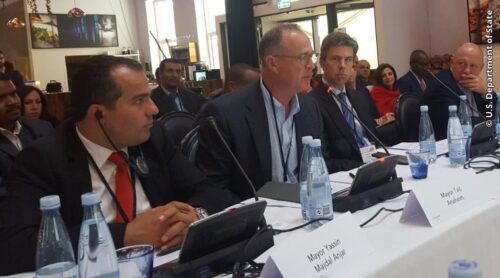The Role of Cities in Countering Violent Extremism

By Michael Duffin
The Strong Cities Network (SCN) is a notable example of a group building resilience against violent extremism among cities and local leaders around the world. Strong Cities Network empowers cities to connect with their global counterparts, share experiences, and develop effective and cost-efficient strategies on resilience. On May 17-19, the city of Aarhus, Denmark is hosting approximately 500 mayors, policy makers, and practitioners from more than 50 countries for the Strong Cities Network’s second annual global meeting.
Launched in September 2015 with support from the U.S. Department of State, and the governments of Denmark and Norway, Strong Cities Network is supported by the London-based Institute for Strategic Dialogue. Strong Cities Network features capacity-building workshops, exchanges involving local policy makers and practitioners, innovation grants, and an online library and forum to exchange good practices. The network has grown to more than 115 members across six continents, including cities like Beirut, Buenos Aires, Chattanooga, Dhaka, London, Los Angeles, Medellin, Mombasa, Mumbai, Paris, and Tunis. Smaller cities that have experienced a high per-capita number of cases of radicalization to violence are also SCN members. For example, Kacanik, Kosovo – a city of roughly 30,000 people – has worked with the network to become a model for how local authorities can work together to curb radicalization and recruitment to violence. As a result, the flow of terrorist fighters to foreign conflict zones has been substantially reduced.
And in other cities, such as SCN members Chattanooga and Orlando, the communities impacted the most by violent attacks in their cities have chosen resilience over isolation and stigmatization. Even before the Pulse nightclub attack in June 2016, perpetrated by an individual who did not live in the community, Orlando had gone to great lengths to encourage social cohesion. Police coached vulnerable youth in sports leagues and the city engaged community groups on a regular basis. At Mayor Buddy Dyer’s press conference in the wake of the attack, he was flanked by members of the Muslim and LGBTQ communities who wanted to show solidarity with each other.
Cities all over the world are developing innovative ways to counter violent extremism. In Aarhus, Denmark, local police officers, educators, social workers, and mental health professionals, work together to engage vulnerable individuals. Known as the “Aarhus Model,” young people on the path to radicalization to violence are partnered with mentors who have faced similar challenges. This program, originally designed to deal with violent right-wing extremists, expanded its focus after the rise of al-Qa’ida and ISIS (Islamic State in Iraq and Syria). Aarhus and other cities in Western Europe including Copenhagen, Rotterdam, and The Hague have been instrumental in mobilizing mayors in the fight against violent extremism. For example, Danish cities have been working with their counterparts in Lebanon and Jordan and will soon expand to cities in Tunisia to help develop prevention and intervention programs of their own. Norway will support a similar initiative between its cities and counterparts in the Middle East and Kenya, employing Strong Cities Network and the Youth Civil Activist Network (YouthCAN).
As cities work to keep themselves safe, strong, and resilient against the threat of terrorism, the Strong Cities Network is playing a key role in connecting communities. A delegation of officials and practitioners from Los Angeles just visited counterparts in London, Molenbeek (Belgium), and the suburbs of Paris. From Aarhus to Zanzibar, Strong Cities Network members are developing inventive prevention and intervention programs to effectively counter violent extremism.
About the Author: Michael Duffin serves as the Policy Advisor in the Bureau of Counterterrorism and Countering Violent Extremism at the U.S. Department of State.
This story was originally published on Dipnote, the U.S. Department of State Official Blog.

